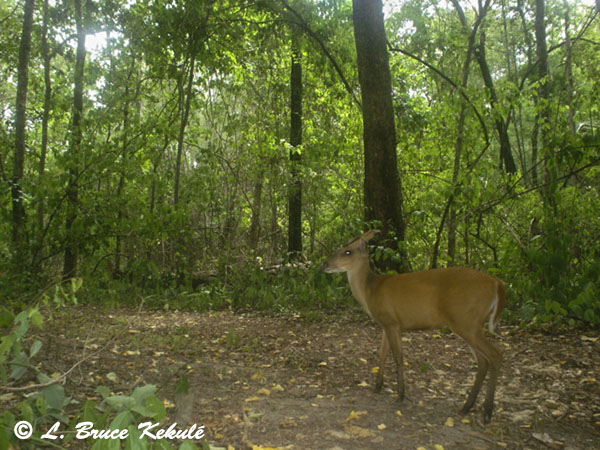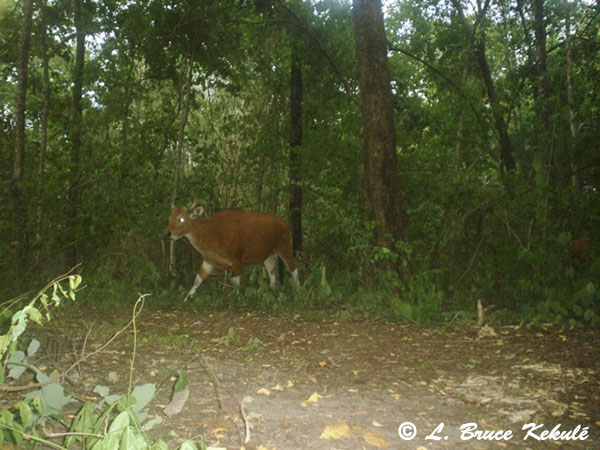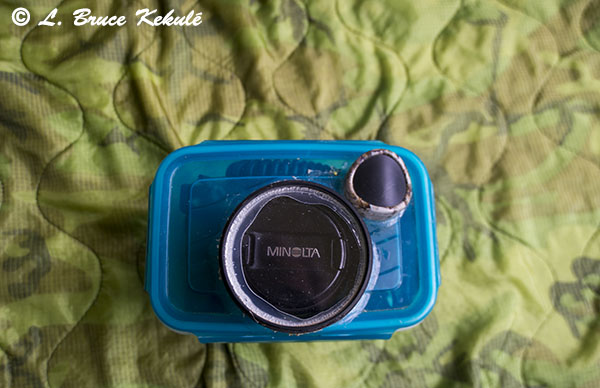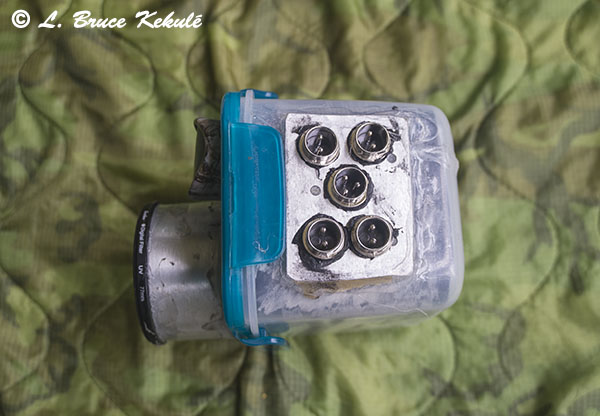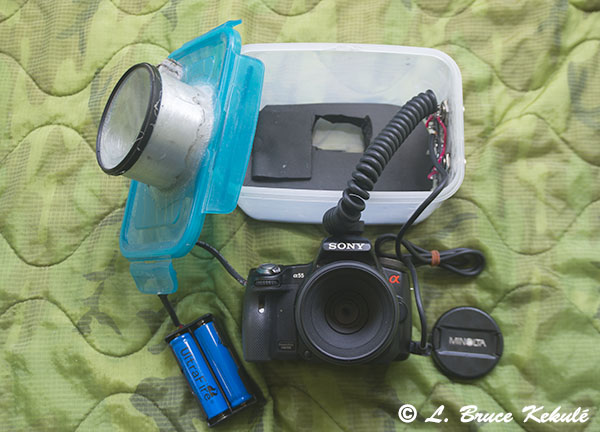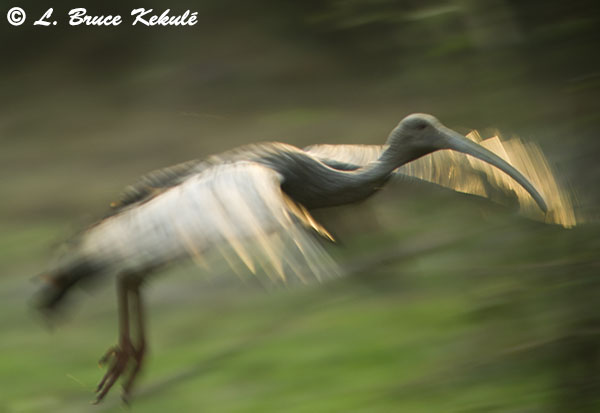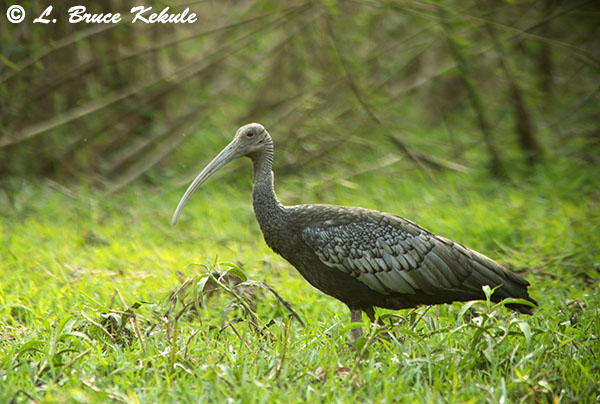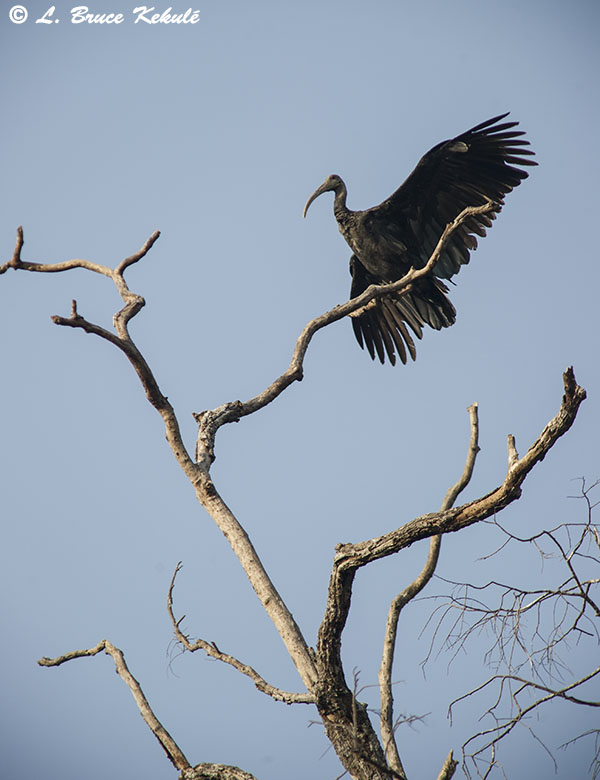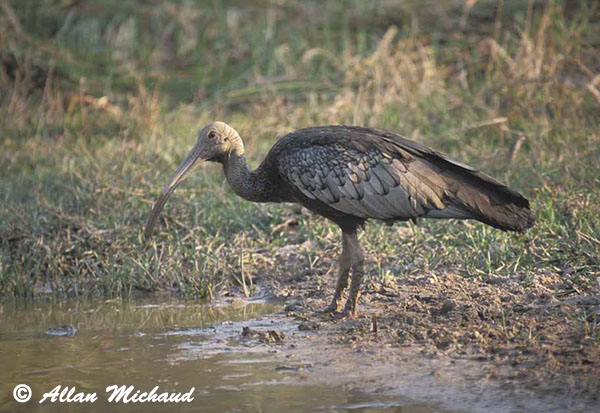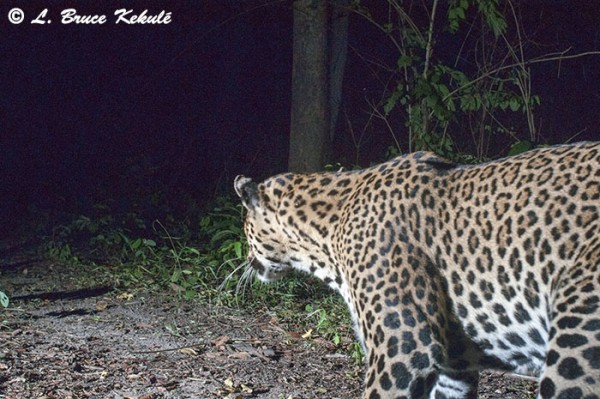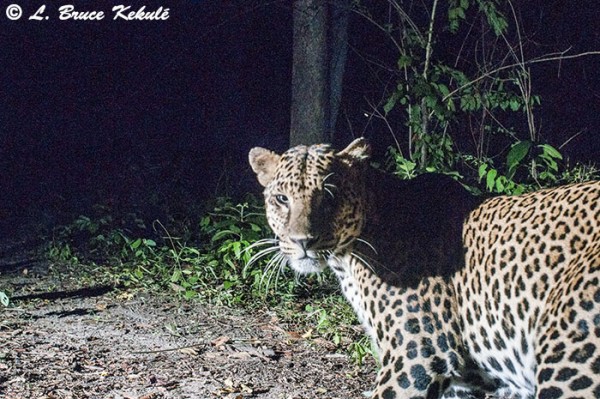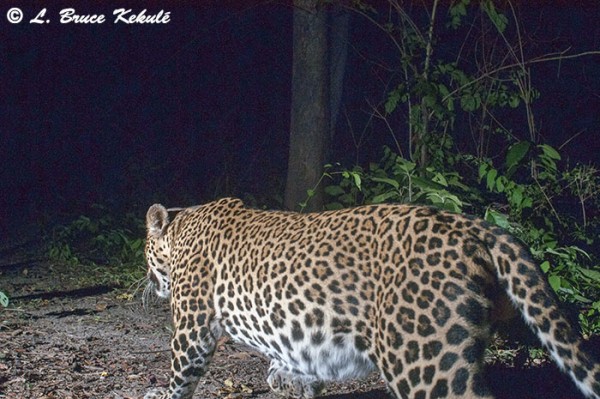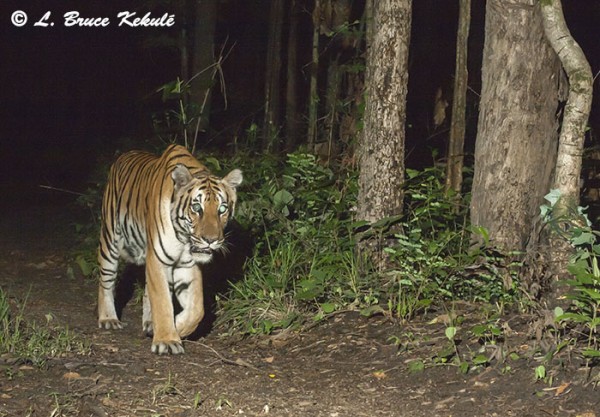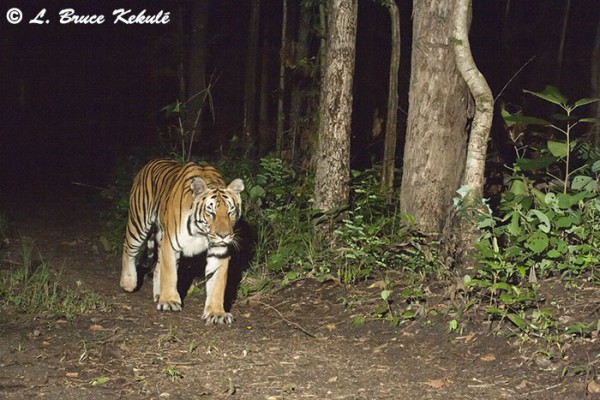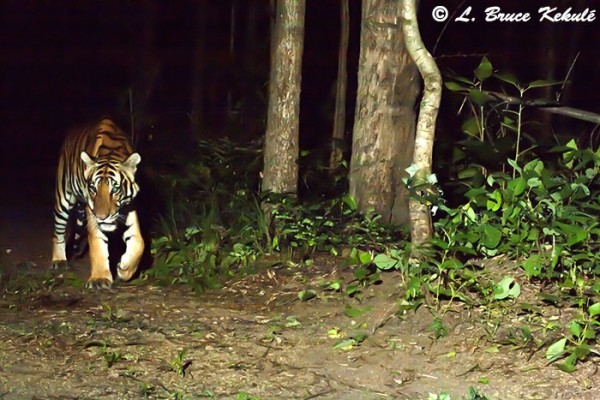Archive for August, 2014
My smallest DSLR camera trap…!
A ‘Hybrid’ trail cam – Sony A55 DSLR/Minolta 50mm macro lens
Sony A55 DSLR – Minolta 50mm Macro lens.
DSLR trail cameras for the most part are pretty big. Camera-trappers have built them mostly using the Pelican 1200 and even the 1300 case, and other makes like Plano and Seahorse large cases have also been used.
I have built a few now and like the smaller Pelican 1150 for my Nikon D700 and D300s plus a Canon 400D and 600D with 8-volt SLA battery packs, and even a smaller Pelican 1120 for a Sony A500 but they are still pretty big and standout sitting on a tree in the forest.
Top view of a Sony A55/Minolta 50mm in a ‘Tupperware’ type box.
In my case, elephant’s will home in on strange objects and strength plus rigidity is the No: 1 priority. With my ‘elephant proof’ boxes and three to four lag bolts, these hard and sharp edged external aluminum boxes have survived the forest giant stomping test many times…!
But I wanted something smaller. After some sole searching, I found this lockable plastic box (a Tupperware type) that would allow a small Sony A55 DSLR to just sit in the box with a Minolta 50mm ‘macro’ lens (just happen to have this lens from my old days when I used Minolta cameras). A pair of 18650 Lithium 4.2 volts for externals is used. The A55 is a 12 megabyte camera and is perfect for a camera trap.
Side view showing connections for flashes (two-pin) and sensor (three-pin).
The Minolta lens works in the Sony perfectly. The snorkel is a length of 77mm diameter thin aluminum tubing secured to the box with Goop. I prefer this to the large, thick and heavy PVC tubing. Goop is also used to attach a 77mm UV filter to the snorkel.
A dedicated ‘elephant proof’ box was built to house the fragile plastic box and camera. I have incorporated a cover to protect the wires and plugs from probing elephant trunks. Four stainless steel lag bolts and a 10mm Python cable secure the box to a tree.
Sony A55/Minolta 50mm showing 18650 4.2-volt externals.
As I won’t be using the flip-up flash or a dedicated hot-shoe flash, I’m using a TTL head and hard-wire everything using two-terminal quick-disconnect plugs for the flashes. A three-terminal plug is used for the sensor, and I seal the plugs with 3M-silicon sealant as shown in the photos. I’ve installed a thin aluminum plate to beef-up this area.
Three flashes are on 10-meter lengths of two-conductor shielded wire with gland fittings on the flash boxes. The fourth flash is on a 15-meter wire to be placed across from the cam hoping to get backlighting of some sort (the set-up and location will require experimentation). I’m using three SB-28s and one SB-80 Nikon flash. All flashes are in ‘Tupperware’ type boxes with elephant proof shrouds made up.
Sony A55 with hard-wired Nikon flashes and SSII hard-wired sensor.
The sensor is a Snapshotsniper SSII with a #5 chip, also on a 10-meter hard-wire cable to be installed on a trail about 6-8 meters from the cam. This way I can focus precisely at the sensor.
I have the perfect place for this cam…to replace the Sony P41 that has captured tiger and leopard plus many other creatures. I will be setting it up in a few days. The rainy season has started and there are not many people around in this area. I’m hoping for some dramatic shots of a black leopard and the other cryptic animals that pass by.
Sony A55 trail cam and ‘elephant proof’ box.
A Sony P41 post with tiger and black leopard to follow…!
A pair of Canon DSLR trail cams…!
A Canon 400D-Nikon 55mm and a Canon 600D-Nikon 20mm
Canon 400D with a Nikon 55mm ‘Macro’ lens on the left, and a Canon 600D with a Nikon 20mm lens on the right.
Working in the Western Forest Complex in Thailand has been extremely satisfying with loads of wild animals passing my cams. This forest is one of the greatest tiger reserves in the world and I look forward to every visit checking my DSLRs…! After the great results from my Canon 400D last month catching a tiger plus yellow and black phase leopards, I decided to finish off these two cams that had been on the bench for sometime.
Both cams in Pelican 1150s with 8-volt SLA external batteries.
As I wanted to leave these cams in the forest for several months over the rainy season, I added an 8-volt SLA battery and hacked into the battery grip (I will do a post on this mod very soon). It was a fairly easy task and both cams fit in the Pelican 1150 with ease plus the SLA battery lying horizontally in the case. After charging up the cam’s batteries and hooking up the externals, they will stay on for months, and just what I needed for a long soak. Time will tell and the 600D is now set-up on a known wildlife trail frequented by the big carnivores including black leopard.
600D showing connections to external sensor and flashes.
I’m using a Snapshotsniper SSII external sensor on the 600D and 400D with both cams set on ‘continuous’ mode. Both sensors are on 10-meter 4-conductor shielded wire housed in ‘Tupperware’ type boxes and hooked up to the cam with 3-prong quick detachable plugs and the sensor boxes with cable glands.
400D showing connections to external sensor and flashes.
The flashes are a mix-pot of Nikon SB-26s and 28s also housed in Tupperware type boxes and hooked up to the cam with 2-prong quick detachable plugs and 10 meters of 2-conductor shielded wire and cable gland on the sensor box. I am standardizing all my flashes with two-conductor shielded-cable and eventually, will be able to inter-change my flashes with all my DSLRs in the field. That way, if I have a problem with a flash (stomped by elephant or some other failure), I will be able to quickly change one out and replace it. That will also go for the three-conductor external sensors…!
600D with external 10 meter hard-wired sensor and flashes.
As usual, I built ‘elephant proof’ boxes that I have made-up for these two Canons. Python 10mm cable locks are used and 3” stainless steel lag bolts are screwed into the tree from inside the box. The faceplate is bolted to the box using six power-torque 10mm machine screws. Camouflage is made up of spray paint (earth brown and army green) plus ‘morning glory’ plastic leaves wrapped with thorny branches to keep the elephants at bay.
400D with external 10 meter hard-wired sensor and flashes.
Hope this helps those people on the forum wanting to build a long-soak Canon ‘Rebel’ sized DSLR home-brew trail cam. I normally don’t use Canon but really like these cams for capturing wildlife. They are quiet and quick enough. The 600D has good file size so cropping is a plus.
600D and ‘elephant proof’ aluminum box.
Actually (don’t tell anybody), I’m changing out two Nikon D300 bodies for Canon 550D or 600Ds…they just seem to work better. But, I’m still sticking to my Nikon lenses with a Canon adapter. Real glass and metal materials are the best lenses for trail cams…but that’s just my opinion…!!
Cambodia is for the Birds: photographing the Giant Ibis
The Northern Plains of Cambodia: Only 250 giant ibis left in the world…!
A giant ibis lifting off from a trapeang (waterhole) in late afternoon.
In early Feb. 2011, the flight to the city of Siem Reap near Angkor Wat in northern Cambodia took about 45 minutes by jet from Bangkok. We touched down safely and the trip was smooth arriving about noon. Going through immigration and customs was fairly quick and hassle free. I then waited out front at the coffee shop and had some lunch and a drink while I waited for my fellow wildlife photographer Allan Michaud, to show up. He lives and works in Phnom Penh and has been there for many years.
A mature giant ibis close to our photographic blind.
After an hour wait, he showed up with a car and taxi driver, and we loaded-up for the trip further north to a place arriving in the late afternoon some 60 kilometers south of the infamous temple ‘Preah Vihear’ (also known as Phra Wihan in Thai) on the Thai/Cambodian border. The centuries old structure sitting on a ridgeline has been the center of controversy, and fighting has erupted many times between the two countries both claiming ownership. The International Court of Justice in The Hague ruled in 1962 and again recently that the temple belongs to Cambodia.
A giant ibis showing wing flair on the first morning.
The taxi got us to our drop-off point safe and sound. The ride up from Siem Reap was hair-raising to say the least as the driver was continually passing slower traffic at break-neck speed around blind corners, and it was white-knuckle for me, and Allan. However, he was more use to living and riding around Cambodia and I had already experienced one bird photography tour a couple years earlier down to the flooded forest on the northern tip of Talay Sap, Southeast Asia’s largest freshwater lake close to Siem Reap. The taxi ride to the lake then was no different.
The same bird taking off.
We finally arrived in the middle of nowhere and several motorcycle taxis were waiting on us. Allan and I loaded up for the two-wheeled part of this trip. By the time we got to the ecotourism lodge set-up in Tmatboey Ibis Ecotourism Project in Kulen Promtep Wildlife Sanctuary in the Northern Plains, it was already late afternoon. We quickly had dinner and retired to our rooms being exhausted from the grueling trip to the lodge setup in the forest. The next morning, we had a quick breakfast and then at 5am, jumped on the motorcycles once again: this time with cameras and daypacks for a trip to a known ibis waterhole, also known as a ‘trapeang’ in Cambodian.
An ibis with food in its beak.
When we got to our destination, the forest was quiet. I looked around and found a tree in a depression that looked perfect for a photographic blind. We quickly set the enclosure with camouflage cloth but decided to leave it till the next morning. We then went looking for other possible ‘ibis’ haunts but these proved to be empty. The next morning, we were back in the blind before dawn and sat quietly waiting. About 7.30am, a lone mature giant ibis landed on a tree high up and called out. We both started shooting and it was great to see this amazing feathered creature on the first day.
A flock of giant ibis feeding at the trapeang.
About 8am, the thundering sound of artillery fire began north of our location. At first, it sounded like carpet-bombing that I had experienced in the Vietnam War back in 1968 while I was working there. And then it dawned on me and Alan: the Thais and Cambodians were shooting at each fighting other over the temple at ‘Preah Vihear’ again. We ignored it and decided to stay put. The next morning, it was a repeat with the thunderous noise for about an hour but it finally stopped.
We sat all day and about 4.30pm, heard and then saw a flock of five giant ibis as they swooped down and landed in front of us on the ground. These huge birds stayed for about 15 minutes foraging and feeding and after they left, my good pal and I let out a whoop. We had just photographed one of the rarest birds on earth and it was a celebration that night with drinks and food at the lodge. Looking back, the ‘Spirits of the Forest’ had answered my prayers and the feeling of accomplishment was overwhelming.
Another giant ibis photographed by my friend Allan Michaud.
My last shot of a giant ibis taking off from the trabeang in late afternoon.
The giant ibis Thaumatibis gigantean has a distinct curved bill, and at dusk and dawn have a repeated, loud, ringing call sounding like ‘a-leurk a-leurk’. The adult is dark grey and the head and upper neck are bare-skinned. There are dark bands across the back of the head and shoulder area and the pale silvery-grey wing tips also have black crossbars. The beak is yellowish-brown, the legs orange, and the eyes dark red. Juveniles have short black feathers on the back of the head down to the neck. Their bills are shorter and their eyes are brown. They consume mainly invertebrates, particularly locusts and cicadas, as well as crustaceans, small amphibians, small reptiles, and seeds.
‘Battered’ Banteng Bull
A short video and camera trap photos of a banteng bull in the ‘Western Forest Complex’ of Thailand. My Nikon D700 and a Bushnell Trophy Cam captured this seriously injured creature. This is ‘raw’ nature and could be disturbing to some…but this is the natural world and how it really is……!
Nikon D300s catches an Asian Leopard
A male cat shows off its family jewels…!
A male leopard with its reproductive organs in full swing…Shot No: 6.
Back at the end of June, I pulled a card from my D300s DSLR trail cam at the ‘big cat trailhead’ and when I looked, I did not see anything so I threw the card in the with the rest of my CF cards.
Shot No: 1
It was somehow put into my D3s but fortunately I did not format it. After doing some work while in the forest last week, I pulled both cards (Nikon D3s had two CF card slots) and downloaded them.
Shot No: 2
Imagine my surprise…! There was a male leopard and he had been captured at night while walking past the D300s. Where the heck did that come from…?
Shot No: 3
I guess my short-term memory is on the blink. Unfortunately, the other two flashes were dead creating a horrible shadow…!
Shot No: 4
Needless to say, I’m lucky I did not lose these shots and of course, shot No: 6 is my favorite…enjoy…!
Shot No: 5
Nikon D300s set to low continuous.
Nikon 35mm manual lens.
ƒ11 @ 1/125 ISO 400
Single SB-28 set to full (the other two flashes did not fire and were dead).
SSII sensor #6 chip – Pelican 1150.
Indochinese tiger ‘eye lash’ speed…!
A Canon 400D trail cam catches a male tiger
Old green eyes’…out on a ‘night prowl’…1st shot…!
A couple of days ago, I was checking my cams and got to my Canon 400D on a forest road somewhere in the Western Forest Complex of Thailand. When I got to the cam, it was still working but only one flash three feet above the cam was firing hence the ‘eye-shine’ . The other two flashes were dead…! Life on two Canon Lithium batteries in 30 second power save mode is excellent so I left them just to see how long they would really last….!
Tiger squinting…..2nd shot.
The flash that fired was a SB-26 which I normally set for slave but somehow the settings was on full-power…needless to say, I was delighted and did back-flips when I saw a tiger again, in about the same position as the female back in June in two shots. In both instances, the tigers had their eyes open on the first shot and squinted by the second in almost the same positions. This reaction time is measured in milliseconds…!
Last month’s female tiger…..1st shot.
Then they both jumped out of the frame before the camera could shoot again. This is 100% luck….also shifted the 400D over a tad to the left for better composition. I have included last month’s female tiger shots so a comparison can be made without having to flip back to the old post.
Female squinting…..2nd shot.
All I can say, it boggles the mind but shows how fast tigers can react……Enjoy…!
Canon 400D set to continuous
Nikon 50mm ƒ1.4 manual lens
Nikon SB-26 set to full power.
1/125 – ƒ8 ISO 400.
SSII sensor #6 chip – Pelican 1150
1st shot – cropped and the rest normal size.







